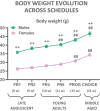Sex and age differences in mice models of effort-based decision-making and anergia in depression: the role of dopamine, and cerebral-dopamine-neurotrophic-factor
- PMID: 37592005
- PMCID: PMC10593617
- DOI: 10.1007/s00213-023-06430-7
Sex and age differences in mice models of effort-based decision-making and anergia in depression: the role of dopamine, and cerebral-dopamine-neurotrophic-factor
Abstract
Mesolimbic dopamine (DA) regulates vigor in motivated behavior. While previous results have mainly been performed in male rodents, the present studies compared CD1 male and female mice in effort-based decision-making tests of motivation. These tests offered choices between several reinforcers that require different levels of effort (progressive ratio/choice task and 3-choice-T-maze task). Sweet reinforcers were used in both tasks. In the operant tasks, females worked harder as the task required more effort to access a 10% sucrose solution. Although males and females did not differ in preference for 10% vs 3% solutions under free concurrent presentation, females consumed more of the 10% solution when tested alone. The operant task requires a long period of training and changes in the DA system due to age can be mediating long-term changes in effort. Thus, age and sex factors were evaluated in the T-maze task, which requires only a short training period. Both sexes and ages were equally active when habituated to the running wheel (RW), but females consumed more sweet pellets than males, especially at an older age. Both sexes had a strong preference for the RW compared to more sedentary reinforcers in the 3-choice-T-maze test, but older animals spent less time running and ate more than the young ones. The DA-depleting agent tetrabenazine reduced time running in older mice but not in adolescents. Cerebral-dopamine-neurotrophic-factor was reduced in older mice of both sexes compared to adolescent mice. These results emphasize the importance of taking into account differences in sex and age when evaluating willingness to exert effort for specific reinforcers.
Keywords: Age; Dopamine; Effort; Mice; Neurotrophic factors; Operant; Running wheel; Sex; Vigor.
© 2023. The Author(s).
Conflict of interest statement
JS has received grants from, and done consulting work for, Shire, Prexa, Chronos, Blackthorn, Lundbeck, NOEMA, and Acadia. On behalf of all the other authors, the corresponding author states that there is no conflict of interest.
Figures









Similar articles
-
Dopamine depletion shifts behavior from activity based reinforcers to more sedentary ones and adenosine receptor antagonism reverses that shift: Relation to ventral striatum DARPP32 phosphorylation patterns.Neuropharmacology. 2018 Aug;138:349-359. doi: 10.1016/j.neuropharm.2018.01.034. Epub 2018 Jun 27. Neuropharmacology. 2018. PMID: 29408363
-
Preference for Exercise vs. More Sedentary Reinforcers: Validation of an Animal Model of Tetrabenazine-Induced Anergia.Front Behav Neurosci. 2020 Jan 30;13:289. doi: 10.3389/fnbeh.2019.00289. eCollection 2019. Front Behav Neurosci. 2020. PMID: 32082126 Free PMC article.
-
The dopamine depleting agent tetrabenazine alters effort-related decision making as assessed by mouse touchscreen procedures.Psychopharmacology (Berl). 2020 Sep;237(9):2845-2854. doi: 10.1007/s00213-020-05578-w. Epub 2020 Jun 19. Psychopharmacology (Berl). 2020. PMID: 32561947
-
The pharmacology of effort-related choice behavior: Dopamine, depression, and individual differences.Behav Processes. 2016 Jun;127:3-17. doi: 10.1016/j.beproc.2016.02.008. Epub 2016 Feb 19. Behav Processes. 2016. PMID: 26899746 Review.
-
Nucleus accumbens neurotransmission and effort-related choice behavior in food motivation: effects of drugs acting on dopamine, adenosine, and muscarinic acetylcholine receptors.Neurosci Biobehav Rev. 2013 Nov;37(9 Pt A):2015-25. doi: 10.1016/j.neubiorev.2013.04.002. Epub 2013 Apr 10. Neurosci Biobehav Rev. 2013. PMID: 23583616 Review.
Cited by
-
Potential therapeutics for effort-related motivational dysfunction: assessing novel atypical dopamine transport inhibitors.Neuropsychopharmacology. 2024 Jul;49(8):1309-1317. doi: 10.1038/s41386-024-01826-1. Epub 2024 Mar 1. Neuropsychopharmacology. 2024. PMID: 38429498 Free PMC article.
-
Influence of aerobic exercise on depression in young people: a meta-analysis.BMC Psychiatry. 2024 Aug 20;24(1):571. doi: 10.1186/s12888-024-06013-6. BMC Psychiatry. 2024. PMID: 39164715 Free PMC article.
-
Pharmacological characterization of sex differences in the effects of dopaminergic drugs on effort-based decision making in rats.Psychopharmacology (Berl). 2024 Oct;241(10):2033-2044. doi: 10.1007/s00213-024-06615-8. Epub 2024 Jun 6. Psychopharmacology (Berl). 2024. PMID: 38842701
-
Operant effort-based decision-making task reveals sex differences in motivational behavior but no long-term effects of adolescent intermittent ethanol in Sprague Dawley rats.Pharmacol Biochem Behav. 2025 May;250:173998. doi: 10.1016/j.pbb.2025.173998. Epub 2025 Mar 17. Pharmacol Biochem Behav. 2025. PMID: 40107424 Free PMC article.
References
MeSH terms
Substances
LinkOut - more resources
Full Text Sources
Molecular Biology Databases
Research Materials

